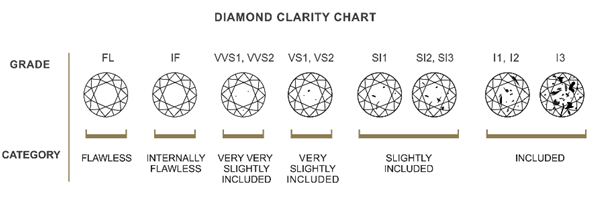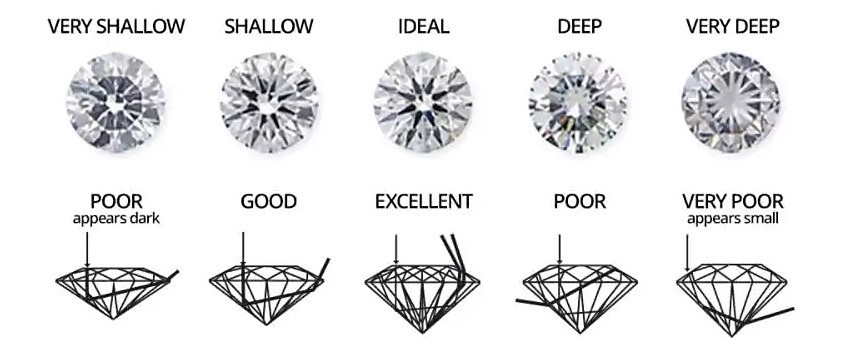4 C’s of Diamonds represent various characteristics of each diamond. They come in different shapes, sizes, colors, and features, representing a diamond in its sparkling uniqueness. Let’s find out a bit more about diamond characteristics. Every diamond is evaluated according to the official grading standards. The majestic stones are ranked based on the Gemological Institute of America (GIA) universal grading system. Diamonds are rated using the 4Cs systematic grading method – clarity, cut, color, and carat weight. The 4Cs of each diamond impact the overall value and flawlessness of diamond’s beauty.
Diamond Clarity
The diamond clarity assessment method helps to identify minor imperfections within the stone and on its surface. The experts are looking for tiny inclusions internally and placing blemishes on the surface. Although, most inclusions are not seen with the naked eye and require microscope equipment. In most cases, diamonds are not affected by these invisible flaws. Usually, gemmologists call these internal characteristics instead of flaws. The spectrum of interior features gives the diamond its unique character.
In memorial diamonds, natural inclusions and blemishes are part of a loved one. Clarity is considered less important than a diamond’s cut and color; however, both affect the overall clarity of a diamond.
All of the 4Cs characteristics are important and should be taken into consideration when purchasing a diamond.
GIA diamond grading scale has 6 categories and 11 diamond clarity grades. It is very rare that diamonds come with no inclusions; it is nearly impossible to find such high clarity within the diamond. To the greatest extent, precious stones appear to have flaws, though these are only visible under 10x magnification. The exception will be diamonds with the lowest grade (I1, 12, and 13), as they may have more noticeable inclusions that may be visible to the naked eye. It is well-known that many diamond characteristics vary depending on the cut and shape. As for small diamonds, it is technically challenging to spot imperfections.
Some types of diamond inclusions:
Cleavage/ Cavities/Internal graining/ /Crystals and minerals
Some types of blemish spots:
Scratches/ Chips/Dark and light dots/ Polish lines
Diamond Cut
The diamond cut creates the symmetry of a diamond and affects its brilliance and luminosity. The popularity of the cuts varies; however, the round brilliant cut remains the classic. The round-cut diamond has become a benchmark for other vibrant cut diamonds as its symmetry and proportions have been perfected over the years. Diamond cutters should consider a few factors regarding the symmetrical arrangement of facets, including the shape and size of a gemstone. Trained graders apply strict requirements when evaluating the diamond. It is worth mentioning that the innovative technology has allowed diamond cutters to perform the procedure with the minimum waste produced.
The brilliance of a diamond depends on its dimensions and facets. The better-proportioned they are, the more sparkle and higher quality they will turn out to have. Out of 4Cs, the cut has the most significant influence on the diamond’s appeal and gleam. When choosing between the clarity and the cut, go with the best cut grade possible, as it will directly affect the stone’s brilliance.
As you can see on the grading scale below, the cut has different characteristics. The three popular elements that are used to describe a well-cut diamond are Brightness i.e., which shows the reflection of white light, Fire i.e., which gives the colors of the rainbow; and Scintillation, i.e., the sparkle that compares the contrast between dark and light areas.
When rough diamonds are cut and crafted by experts, they follow the standard requirements to create outstanding quality cuts that reflect the most light. Additionally, diamonds can be certified by GIA (Gemological Institute Of America) or IGI (International Gemological Institute). These institutions analyze each diamond and give their grading on 4 Cs (cut, carat, clarity, and color).
Diamond Color
There are multiple color variations to choose the diamond from. You have to consider this when selecting the diamond that stands out the most and has the most meaning for you. It is important to know that the color affects the price of the diamond, as the diamond creation technicalities and time needed is influenced by diamond color.
Saint Diamonds memorial diamonds come in colors, such as, yellow, black, red, green, blue, and colorless. Naturally occurring diamonds can be found in almost any color and may be grey, pink, white, brown, yellow, or green. The most expensive ones are red and colorless diamonds.
You should pick your desired color and consider the budget, as well as your personal preferences. As mentioned earlier, the diamonds’ shape and cut are also crucial as they will create more sparkle, and the color will stand out immensely. It is also vital to consider the color of the setting, as the precious metal will compliment the color grade of your diamond. Choosing white or platinum gold will make your colorless diamond stand out and sparkle more. On the other hand, yellow gold will create a warm glow and is best with toned-down color diamonds.
Diamond color is measured with the GIA color scale from D (colorless) to Z (light yellow/ brown color). The highest quality diamonds are perfectly colorless, which indicates a good value. The lower the quality, the more yellow tint is seen in the diamond. Colored and colorless diamonds are usually graded and valued differently.
Diamond Carat Weight
As widely known, a carat is a unit of weight for diamonds and other gems, with the word originating from the Carob tree, as the carob seeds were first used to weight goods. One carat equals 200 milligrams (0.200 grams). The price of a 1-carat diamond fluctuates between $1,300 and $16,500; however, it depends on the clarity, cut, and shape. An ‘international carat’ of 205 milligrams was proposed in 1871 by the Syndical Chamber of Jewelers in Paris and accepted in 1877 by the Syndical Chamber of Diamond Merchants in Paris.
It is not always necessarily true that the diamond has the most terrific value because of its carat weight. The carat refers to a diamond’s weight, and it is nothing to do with its size. The carat weight doesn’t relate to the unique sparkle. As mentioned earlier, the result of a gorgeous sparkle is the precisely crafted and performed cut. Note that if a diamond has been cut poorly, it will have an impact on the carat weight, whereas a smaller carat weight diamond with an excellent cut will be of a higher value.
A few abbreviations for carat weight indicate different aspects of it. The most used abbreviation is ct which means carat. It also denotes to a carat weight of a single diamond or gemstone. Others include: cw – weight of a single stone; dw – diamond weight; ctw – carat total weight.
Diamond Certification & Grading Reports
An official GIA (Gemological Institute of America) or IGI (International Gemological Institute) diamond certificate or grading report is mostly respected in the diamond industry, with proven quality reviews and high-set standards, followed by exceptionally trained gemologists. Other laboratories besides the GIA include the AGS (American Gem Society), the EGL (European Gemological Institute and the HRD (Hoge Raad voor Diamont). Every lab will grade the diamonds according to their standards, grading protocols, and systems.
You might consider buying a diamond and class it as an investment. Memorial diamonds have a more personal touch, as these particular gems are considered extremely valuable for individuals who lost their loved ones. Nonetheless, the diamond grading and assessing process is the same as the mined diamonds. The report starts with 4Cs – cut, clarity, color, and carat and includes the exact measurements and characteristics of a diamond, with a detailed plotted diagram and a map of the diamond’s proportions attached to the grading report.
The critical importance of a diamond certification is highly significant, at times the assessment is referred to as the 5Cs. The certification will provide information and verifies the ownership in case of repairs or insurance inquiries. Diamonds that have got graded by the GIA and the IGI will make it easier for you to claim the quality and characteristics of the diamond. Lastly, the grading report will be handy if you decide to sell your diamond one day. Of course, memorial diamonds are not taken into account, as these have a different purpose and signify more to the owner.
4 C’s of Diamonds – Lab- Grown Diamonds
Diamonds grown in a laboratory are called synthetic, cultured, lab-created, or man-made; however, what you decide to name them doesn’t change the fact that they are extremely popular. Manufactured diamonds are produced in a laboratory setting under the supervision of educated experts. Diamonds are generally grown in a controlled environment, and it takes several months to grow a diamond. Lab-grown diamond technology has rapidly developed over the years as the interest in synthetic diamonds has impressively increased.
The lab-grown diamonds have the same properties as natural diamonds. They have the same sparkle, clarity, and color. The range of man-crafted diamonds is broader and more accessible to the customer as natural diamonds cost more. Cultured diamonds consist of the same pure carbon as mined diamonds, the quality of the lab-grown diamond can be evaluated by the experts who use innovative technology; therefore, any imperfections will not be seen with a naked eye.
4 C’s of Diamonds – examination
High-Pressure High-Temperature method imitates the natural process under which the diamonds are formed. In order to create a lab-grown precious stone, it requires a seed planted with the purified material from ashes, hair or animal fur placed into a piece of high-tech equipment under extreme temperatures. The seed works as a conductor for the lattice of carbon to grow the diamond to a desired size and carat weight. Lab-grown diamonds are then examined for 4Cs by gemologists in an independent way. In the result, the individual grades are recorded to present the grown diamond with its ultimate degree and certification.
Sources:






